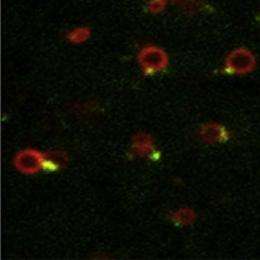Researchers discover mechanism for signaling receptor recycling

An international team of researchers led by Carnegie Mellon University's Manojkumar Puthenveedu has discovered the mechanism by which signaling receptors recycle, a critical piece in understanding signaling receptor function. Writing in the journal Cell, the team for the first time describes how a signaling receptor travels back to the cell membrane after it has been activated and internalized.
Signaling receptors live on the cell membrane waiting to be matched with their associated protein ligand. When they meet, the two join together like a lock and key, turning on and off critical functions within the cell. Many of these functions play a role in human health, and each new discovery about how these complex receptors work provides a potential therapeutic target for conditions including heart, lung and inflammatory disease.
After the receptor and ligand unite, they enter the cell packaged in a container called a vesicle, which delivers them to an even larger container inside the cell called an endosome. From the endosome, receptors can take one of three routes: they can travel to the lysosome and be degraded; travel to the Golgi apparatus and be processed; or the receptor can separate from its ligand and recycle back to the cell membrane via a finger-like offshoot called a tubule.
Some receptors, like nutrient receptors, are recycled back to the cell membrane very quickly through a continuous and unregulated process called bulk recycling. In the case of signaling receptors, researchers noticed that they seemed to recycle at a slower rate and in a more regulated manner. The signaling receptors took minutes to return to the cell surface, indicating that they might not be following the same bulk pathway as other classes of receptors.
"Nutrient receptors can be recycled very quickly without causing any harm, but uncontrolled recycling of a signaling receptor can have serious consequences. For instance, unrestrained signaling through the receptors for adrenaline has been linked to heart failure," Puthenveedu said. "If we can control how fast these receptors travel back to the surface and sequester them inside the cell, we would potentially have a new class of therapeutic targets."
To begin to determine how signaling receptors recycle, Puthenveedu and colleagues looked at the beta-2 adrenergic receptor (b2AR), the receptor for adrenaline and noradrenaline. The receptor is a member of the G protein-coupled receptor (GPCR) family, a group of receptors that interact with molecules responsible for cellular communication such as neurotransmitters and hormones. GPCRs are well studied because they play a pivotal role in cells' chemical communication circuits that are responsible for regulating functions critical to health, including circuits involved in heart and lung function, mood, cognition and memory, digestion, and the inflammatory response.
Puthenveedu and colleagues used live cell confocal fluorescence microscopy to label and image b2AR and the tubules by which it recycles, allowing them to visualize what was happening after the signaling receptor was internalized. They found that while the receptors were still being recycled via tubules, much like nutrient receptors, the tubules were not the same. These b2AR tubules emanated from specialized regions, or domains, on the endosome that were marked by a protein network containing actin. These unique domains, which the Carnegie Mellon researchers named Actin-Stabilized Sequence-dependent Recycling Tubule (ASSERT) domains, provided a cellular scaffold. The scaffolding trapped the receptors and slowed the release of the tubule from the endosome, therefore controlling receptor recycling. The researchers believe that they could use these domains, which are essential for signaling receptors to be sorted into the appropriate, slower recycling pathway rather than the faster bulk recycling pathway, as pharmaceutical targets for diseases that result from abnormal cell signaling.
Puthenveedu plans to continue studying receptor recycling in other types of receptors, including opioid receptors. Opiod receptors are the targets of several drugs that are often clinically abused. This research could open up a new area of study in addiction research.
More information: This study was published in the Nov. 24, 2010 issue of Cell.
Provided by Carnegie Mellon University














